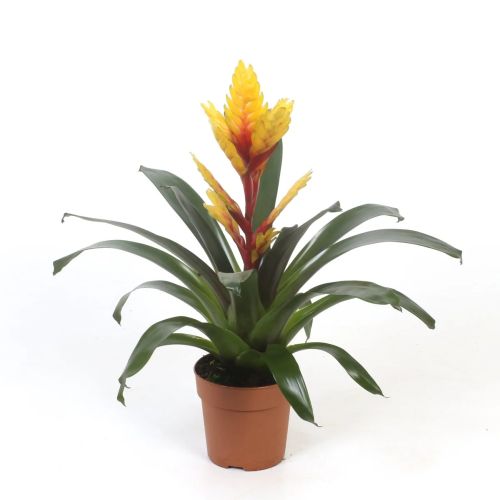Flaming Sword Bromeliad (Vriesea
splendens)
Last
updated: August 3,
2025
Care Sheet List
Bromeliads
are exotic and relatively low-maintenance plants known for their
vibrant,
long-lasting flower spikes and unique rosette-shaped foliage. Many
common
bromeliads are epiphytes, meaning they grow on other plants in nature,
not in
soil.
Lighting
Bromeliads
generally prefer bright, indirect light. Some
varieties can tolerate
more light, and others prefer less, but indirect light is a safe bet
for most.
Avoid direct, scorching sun. An east or west-facing window is usually
ideal.
Watering
Routine
The most
unique aspect of bromeliad watering is that most should be watered
through
their "cup" or "tank" (the central well formed by their
leaves). Keep this cup filled with clean, filtered water,
distilled water,
or rainwater. Flush out the old water and refill it every 1-2
weeks to
prevent stagnation and bacterial growth. Additionally, moisten the soil
(if
it's potted in soil) very lightly every few weeks, allowing it to dry
out
completely between waterings. The roots are primarily for anchoring,
not for
nutrient uptake.
Fertilizer
Requirements
Bromeliads
are light feeders. Fertilize very sparingly, if at all. If you choose
to
fertilize, use a balanced liquid fertilizer.
- Commercial Recommendation: Products like Miracle-Gro
Indoor Plant Food (Liquid) or Schultz Liquid Plant
Food can work. Dilute these commercial concentrates to achieve approximately 10-25 ppm N
in your final solution. This is often equivalent to using them at "1/8
to 1/4 strength" of the package's recommended dose. Do not pour
fertilizer into the central cup; instead, mist the diluted solution
onto the leaves or apply a tiny amount to the soil.
- DIY Fertilizer Suggestion: For very light feeding, use your homemade 1-1-1 liquid fertilizer concentrate (Balanced).
- For 1-1-1 concentrate (10,000 ppm N): Apply at a "Very Light Feeding" rate, using 1 ml to 2.5 ml per 1 liter of water (resulting in ~10-25 ppm N, 10-25 ppm P₂O₅, 10-25 ppm K₂O). See recipe details.
- Schedule: Fertilize once every 1-2 months during the spring and summer.
Misting
Requirements
Bromeliads
appreciate moderate to high humidity. While keeping
their central cup
filled helps, occasional misting with room-temperature water can also
be
beneficial, especially if your indoor air is dry.
Pot Size
and Soil Type
- Pot Size: Bromeliads have
small root systems and do not need large pots. Choose a pot that is just
large enough to support the plant and prevent it from
toppling over. A 4-6 inch pot is often sufficient for a mature plant.
Ensure the pot has drainage holes.
- Soil Type: If your
bromeliad is potted, it's not in regular potting soil. It needs an extremely
well-draining, airy, and fast-drying mix that mimics its
epiphytic nature. An orchid bark mix, a mix of peat moss and perlite,
or a special bromeliad mix works well. The soil is primarily for
stability, not for providing nutrients.

